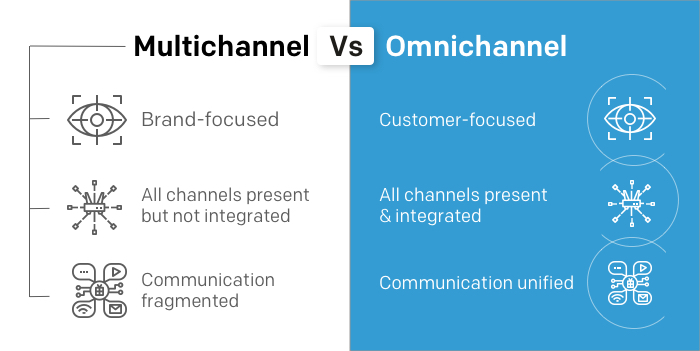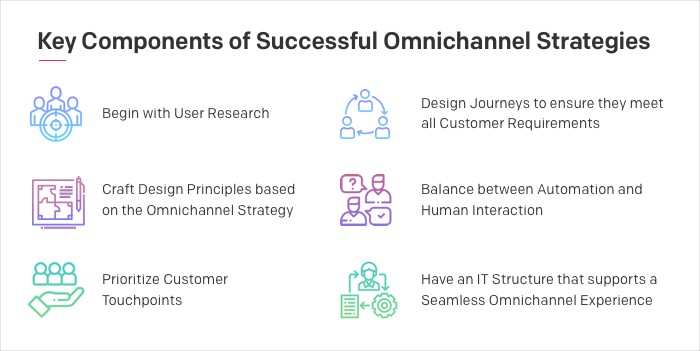Enterprises across consumer goods, B2C and B2B believe that customer experience can be an edge to attract and retain customers. While a digital medium is a key element of CX, customers decide when and on which channel they want to contact a brand, for what type of information, during which stage of the sales cycle, and so on. Brands may be under pressure to be present across channels (which may not be required) and also orchestrate a positive and cohesive omnichannel experience.
What is Omnichannel Customer Experience?
At its core, the omnichannel promise is simple; it means supporting customers effectively and cohesively across all digital channels, and all the different ways in which customers and organizations can interact with each other. The overarching goal is to ensure that the product or service being offered makes the best use of the channel and helps in fostering a consistent, positive customer experience.
Omnichannel CX can thereby be summed as the cumulative effect of the strategically planned user experiences that extend across all channels, devices, and incorporates the brand’s tonality across all designs and messaging seamlessly and consistently.
Omnichannel CX success, however, is not merely limited to the number of channels integrated as part of the customer communication cycle. There’s a lot more to an Omnichannel CX strategy.
The CX vision of your brand is exclusive to the experiences you wish you create. It is about the larger purpose you wish to accomplish and the feeling you would like to invoke in your customers. Brands should thereby formulate their exclusive omnichannel definition to create a strategy for managing omnichannel experiences efficiently.
Why do brands struggle with Omnichannel CX Transformation?
One of the most common reasons brands struggle in this area is because they are channel-aligned rather than customer-aligned. Also given the surge in customer touchpoints, enterprises are overwhelmed and tempted to be present across platforms in the hope to garner a competitive advantage. The key, however, is to identify what works, carefully plan and execute a strategy that resonates with your brand and customer vision.
Brands with omnichannel customer engagement strategies retain over 89% of their customers on an average. Tapping into the right combination of omnichannel and customer experience trends will be the key to success for enterprises, business leaders, marketers, and CX professionals in 2020.
Is Multichannel and Omnichannel experience the same thing?
In multichannel communications, the ‘brand’ remains the focus through which businesses engage consumers by sharing relevant content across multiple touch-points. Most brands often apply multi-channel marketing methods as it seems quick and easy to implement. As the nature of multichannel communications is fragmented, the messaging is not necessarily seamless or consistent across channels. This approach does not focus on creating a unified voice by optimizing the customer experience across channels.
On the contrary, omnichannel experience focuses on creating a unified customer experience from the first to the last point of contact, gathering customer insights and data along the journey to provide relevant and integrated messaging throughout – the ‘customer’ being the point of focus.
Brands embarking on an omnichannel transformation must thereby ensure that all channels are optimized for each customer interaction. And to be able to achieve this, they must seek to understand what customers truly care about at a granular level.
So what do customers truly care about?
- Speed and flexibility
- Reliability and transparency
- Simplicity and clarity
- Proactive outreach and timely communication
- Empathy and care
That said, not all customer expectations can be categorized into specific segments. Brands should explore ways to gather direct feedback and insights from customers to understand what matters most to them and why. Additionally, not all these factors can impact the overall experience. It could be a combination of these at varying degrees and more that can contribute to the overall experience. It’s thereby critical to analyze the factors that can make all the difference. While speed might be the top priority for one brand, timely customer communication might be the key to another.
Let’s explore the essential components for brands to consider while crafting an exclusive omnichannel experience.
Begin with User Research
User research is the foundation for creating a successful product or service. It lays the user at the center of the experience and helps in crafting offerings that align with the user’s needs. It’s essential to align your omnichannel strategy with a scientific technique like user research to gauge and assess what users say vs what they do, which could often be remarkably different. The insights with user research can be integral in creating a befitting omnichannel strategy and help in understanding the key triggers that influence a positive customer experience across channels.
Craft Design Principles based on the Omnichannel Strategy
Considering the surge in digital platforms and technologies, the way ahead for brands to differentiate and garner a competitive advantage is to create offerings embedded in an intuitive design interface that is custom built to match the customer persona. Design principles that align with the omnichannel strategy can help in influencing the customer communication process with insights about the most receptive channels that can increase engagement and elevate the customer experience to a whole new level.
Prioritize Customer Touchpoints
Not all touchpoints are significant for every business. Even within a brand, the touchpoint that works for one service might not be apt for another. Prioritize customer touchpoints in the context of the business and focus on the ones that can have the most significant impact on the overall customer experience.
Design Customer Journeys to ensure they meet all Customer Requirements
Cluster customer segments by determining where their buyer journey begins and identifying all the touchpoints they prefer & the triggers that lead to desired outcomes. By identifying what leads to cart abandonment, retail brands can modify the customer journey and enhance the shopping experience across channels. By mapping customer journeys and beginning with the end objective in mind can help brands in setting goals, prioritizing the most important journey; analyzing the complexity involved in enhancing the journey and what this means to the customer.
Balance between Automation and Human Interaction
While customers expect brands to understand their preferences with intelligent technology they also expect empathetic human interactions depending on where they are in the journey. Maintaining a fine balance of both into the overall customer experience can be the real differentiator for brands. By understanding when a conversation needs to switch from a bot to an agent especially when a customer has a specific or unique request can bring in a remarkable difference to the customer experience.
Have an IT Structure that supports a Seamless Omnichannel Experience
Seamless user experiences are close to impossible without the right technology in place. The changing consumer preferences, the convergence of technology, and the dynamic business environment are opening doors for new opportunities.
The Way Forward
Today, brands need to focus on creating effortless experiences and be where consumers are. They need to look at ways to create tailor-made user experiences that go beyond web and mobile applications and integrate these with multi-experiences that keep in mind both – the user’s needs and modes of interactions. The multi-experience phenomenon is about moving away from a single point of interaction to incorporate multisensory and multi-touchpoint interfaces like voice, chat, AR, and wearables.
To succeed and capitalize on greater business opportunities, enterprises will have to adopt an agile and customer-first development process that evolves with customer needs. With new technologies and applications like Multi-experience development platforms in the limelight; brands need to be more open about experimenting and implementing these technologies that can enhance the overall customer experience remarkably.

